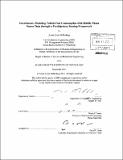| dc.contributor.advisor | Sanjay E. Sarma. | en_US |
| dc.contributor.author | Oehlerking, Austin Louis | en_US |
| dc.contributor.other | Massachusetts Institute of Technology. Dept. of Mechanical Engineering. | en_US |
| dc.date.accessioned | 2012-01-30T17:05:26Z | |
| dc.date.available | 2012-01-30T17:05:26Z | |
| dc.date.copyright | 2011 | en_US |
| dc.date.issued | 2011 | en_US |
| dc.identifier.uri | http://hdl.handle.net/1721.1/68950 | |
| dc.description | Thesis (S.M.)--Massachusetts Institute of Technology, Dept. of Mechanical Engineering, 2011. | en_US |
| dc.description | Cataloged from PDF version of thesis. | en_US |
| dc.description | Includes bibliographical references (p. 106-109). | en_US |
| dc.description.abstract | Vehicle energy efficiency has become a priority of governments, researchers, and consumers in the wake of rising fuels costs over the last decade. Traditional Internal Combustion Engine (ICE) vehicles are particularly inefficient on high traffic or urban roadways characterized by stop-and-go driving patters. We have developed a novel regression model named StreetSmart that can serve as a transfer function between 4 traffic classification parameters we call "Energy Indices" and the fuel consumption of specific vehicle makes. In formulating the model, we show that average speed, which is the most common metric used to report traffic, is actually inadequate to quantify the impact of traffic conditions on bulk energy consumption. Rather, we use an analysis of traffic microstructure, which is the detailed acceleration profile of individual vehicles on a road segment. Using data logged on OBD-II and smartphone devices from over 600 miles of driving, we have shown that the model is capable of predicting fuel consumption with an average accuracy of over 96% using regression coefficients obtained from the same vehicle make and similar road types. Mean prediction error for all cases ranged from -2.43% to 0.06% while the max prediction error was 7.85%. We have also developed a framework for the broader StreetSmart System, a participatory sensing network that will be used to crowdsource mass quantities of smartphone accelerometer and GPS data from drivers. We propose a system architecture and discuss problems of distribution, reliability, privacy, and other concerns. Finally, we introduce future applications of StreetSmart, including hybrid vehicle drivetrain power management, electric vehicle range estimation, congestion pricing, and traffic data services. | en_US |
| dc.description.statementofresponsibility | by Austin Louis Oehlerking. | en_US |
| dc.format.extent | 109 p. | en_US |
| dc.language.iso | eng | en_US |
| dc.publisher | Massachusetts Institute of Technology | en_US |
| dc.rights | M.I.T. theses are protected by
copyright. They may be viewed from this source for any purpose, but
reproduction or distribution in any format is prohibited without written
permission. See provided URL for inquiries about permission. | en_US |
| dc.rights.uri | http://dspace.mit.edu/handle/1721.1/7582 | en_US |
| dc.subject | Mechanical Engineering. | en_US |
| dc.title | StreetSmart : modeling vehicle fuel consumption with mobile phone sensor data through a participatory sensing framework | en_US |
| dc.title.alternative | Street Smart | en_US |
| dc.title.alternative | Modeling vehicle fuel consumption with mobile phone sensor data through a participatory sensing framework | en_US |
| dc.type | Thesis | en_US |
| dc.description.degree | S.M. | en_US |
| dc.contributor.department | Massachusetts Institute of Technology. Department of Mechanical Engineering | |
| dc.identifier.oclc | 773823650 | en_US |
